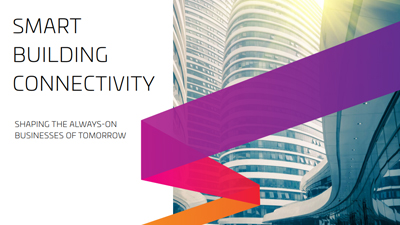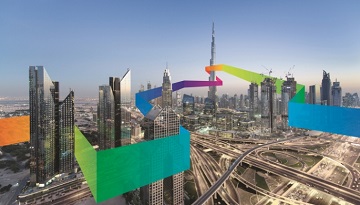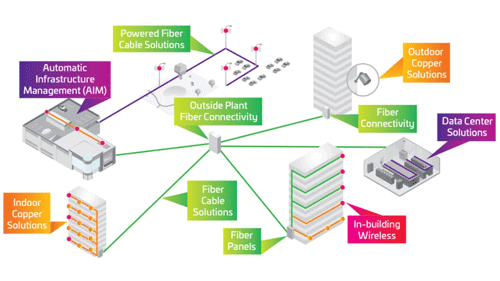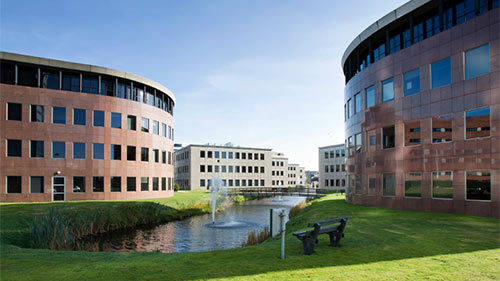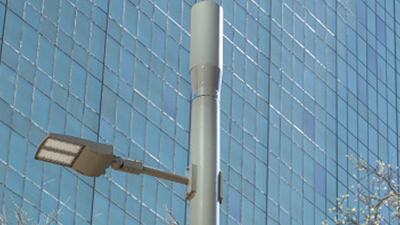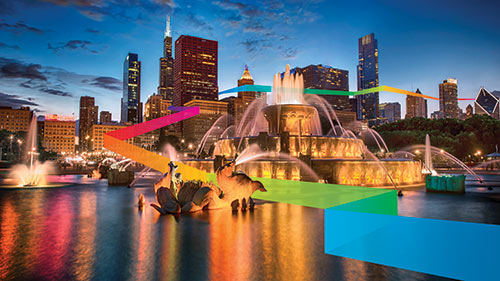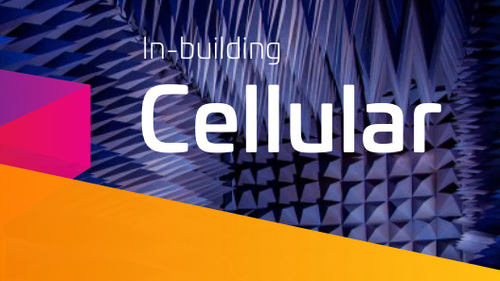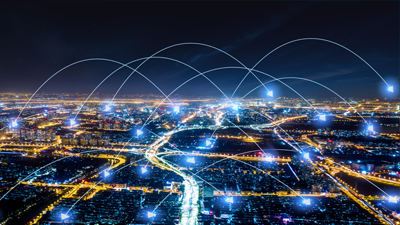Smart spaces: enhanced, connected urban environments of tomorrow
Smart spaces are physical environments enabled by technology to make life easier and more comfortable, campuses more pleasant, companies more efficient and productive, and cities smarter and more sustainable. They are immersive, interactive spaces that use digital solutions to connect people, processes, services, and systems to the benefit of all.
The rapid advance of digital technology has seen smart cities fast become part of everyday life: intelligent waste management systems, smart street lighting and traffic management, and connected air quality sensors are just a few real-world examples already in place. But more than that, we’re all now becoming used to digital workplaces, connected factories and smart homes—which all leverage connectivity and data to give us better experiences.
Moving forward, smart spaces are expected to keep transforming daily life in so many ways. Smart buildings, smart campuses and smart cities are all set to enhance experiences for visitors and residents, to help businesses reduce costs and drive sustainability, and—thanks to data analysis—improve services and systems on an ongoing basis.

In this article we will look at the technologies that are powering smart buildings, smart campuses, and smart cities today and equipping them for continuous transformation tomorrow.
Would you like to read offline?
Download a PDF version of this article to read again later.
Stay informed!
Subscribe to The Enterprise Source and get updates when new articles are posted.
Our connected world
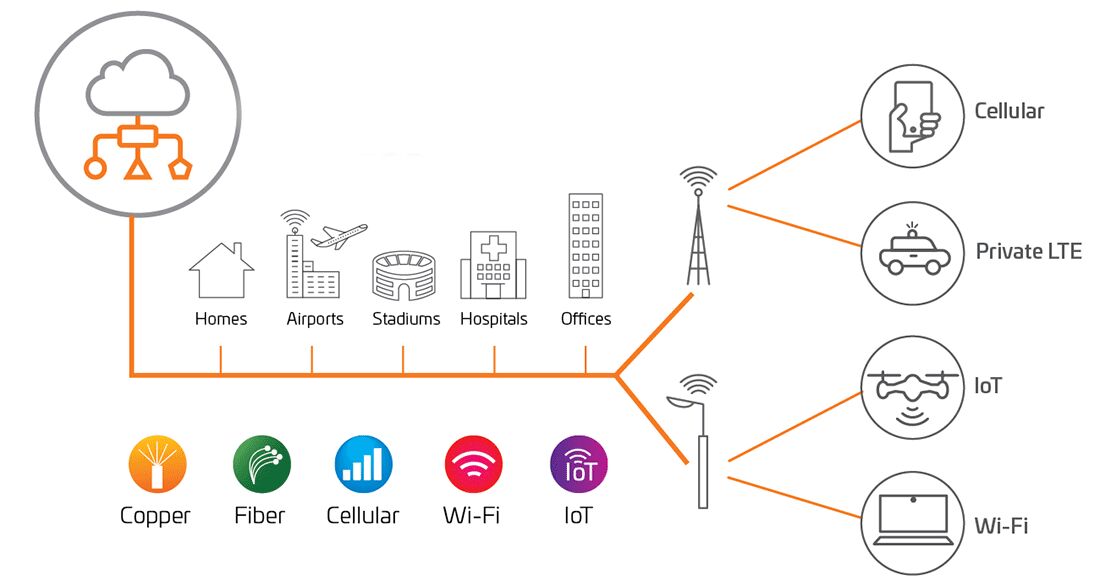
Connectivity: the fourth utility powering smart cities, campuses, and buildings
By 2050, 68 percent of the world’s population of 9.8 billion will live in urban areas1 . It is projected that India will have added 416 million urban dwellers and China 255 million by then.
It’s not difficult to predict that this shift will likely require urban areas to leverage digital tools to drive innovative and sustainable infrastructure solutions that efficiently harness data, energy, space, budgets, and time. It’s a more sustainable and efficient approach that also improves the quality of life for citizens in these communities. This is the vision of a smart city: a sustainable space built on ubiquitous, high-performance, reliable connectivity and data.
Whether a university, hospital or corporate headquarters, all campuses face unique challenges around communication networks. Speed, capacity, flexibility, scalability, and cost all must be factored into connectivity decision-making.

One common error in planning smart spaces is developing siloed applications to solve short-term challenges. Instead, we recommend taking a long-term, visionary approach using a federated solutions model: It will be more cost-effective in the long run and provide a digital connectivity platform on which communities will be able to build applications and hardware. It isn’t enough for site developers to focus on isolated projects like hospitals, corporate HQs, or sports venues. These assets all need digital interconnection throughout to give end users an enhanced experience. This thinking should extend to parking, traffic management, crowd management, retail outlets and restaurants around buildings and spaces, and how they can positively impact the user experience.

What is a smart space?
What are the differences between a standard building, campus or city and a smart building, campus or city? Digital innovation that puts the user experience in the space first.

Standard space
Independent and separate infrastructure for different networks
Proprietary space management
No infrastructure to support IoT
No dedicated indoor mobile network or coverage from outdoors
Separate power and connectivity grids, often siloed by applications and not always covering entire space

Smart space
Convergent network, single, unified IP over Ethernet physical network layer
Integrated, IP-based space management systems
Future-ready infrastructure able to support Internet of Things (IoT) applications and devices
In-building cellular coverage
Integrated power and connectivity systems
Smart buildings use digital infrastructure and data to make them more intelligent. They can help organizations increase efficiency, reduce costs, and streamline building operations. But what powers connectivity in a smart building today? An integrated communications infrastructure that supports wired and wireless networks and applications.

A typical smart building includes:
Internet of Things (IoT)
Essential to powering smart spaces, IoT-connected objects and services drive efficiency, convenience, and new business models.
Converged infrastructure
Low-cost, easily installed cable solutions can help smart buildings make deployments simpler.
Universal connectivity grid
A plan for total connectivity across the organization—no matter where users might be connecting from—and to support new edge devices being added to the network.
Automated infrastructure management (AIM)
The ability to automatically track all connectivity and connected devices and document the entire network.
Power over Ethernet (PoE)
More connected devices require more power. PoE can enable smart buildings to support them all.
A/V and HDBaseT
Standardized audio and video connectivity make it easy to transfer multiple media formats across the network. HDBaseT is connectivity that enables transmission of ultra-high-definition video, digital audio, dc power, Ethernet, USB 2.0, and other control communications over a single category cable.
In-building wireless (IBW)
Wi-Fi is only part of the picture; in-building wireless brings reliable cellular coverage to every part of the building.
Low-voltage lighting
Flexible and efficient lighting contributes to sustainability targets.
Energy savings
A central part of building management—lower energy usage and cost reductions.
Security
Essential in the IoT era—more connected devices means more potential threat vectors. Protect your network from threats wherever they come from.
Safety
Smart buildings can help reduce risk to people or property should unforeseen events occur.
To learn more:
eBook
Smart Building Connectivity
Solutions
Smart Buildings

Video
Reliable Networks for Smart Buildings
Insights
Cat 6A: the Fact File
Insights
Structured Cabling Systems: the Fact File
A smart campus connects devices, applications, and people to enable new or enhanced experiences and improve operational efficiency. It is built on ubiquitous, reliable wired and wireless connectivity—both indoors and out. It connects and enables all the people, devices and applications on campus and lets them interact with each other digitally. A converged network can scale to include all campus buildings and the links between them.

A typical smart campus includes:
State-of-the-art infrastructure
A network design based on experience, skill, and quality to provide total campus network solutions of any scale; flexible fiber, copper, and wireless infrastructure—built to work together
Future-proof network
Powered fiber network that both connects and powers edge devices and takes the advantages of PoE past industry-standard length limits of 100 meters
Intelligent automation
Intelligent, automated management for increased end-to-end efficiency and security
Ubiquitous coverage
Seamless five-bar cellular coverage—both indoors and outdoors across the campus
Strong Wi-Fi
Reliable, high-performance Wi-Fi inside and outside buildings, with simple, secure access, which can be leveraged to deliver traffic for multiple IoT networks
Sustainable systems
Connected indoor and outdoor lighting, smart environmental controls, smart water and power management to drive sustainability on campus
Personalized experience
Location-based services and data analytics across campus to provide users with tailored services and experiences
Safe and secure
Integrated safety and security systems
To learn more:
Brochure
Welcome to the CommScope connected campus
eBook
Introducing the Smart Campus
Solution Brief
Smart campus safety
Smart cities exist because ubiquitous broadband connectivity2 exists. This connectivity fosters innovative solutions, drives the creation of new services for citizens and visitors, and makes smart cities vibrant socio-economic hubs that benefit both businesses and residents. International Telecommunication Union (ITU) research demonstrates that communities with access to ultrafast, all-fiber broadband achieve higher GDP per capita, create more jobs and foster more start-up businesses3. So much so that broadband infrastructure could now be viewed as an essential utility like gas, electricity, and water.

A typical smart city includes:
State-of-the-art infrastructure
City-wide broadband networks built using fiber, the primary connectivity technology that can support current and new applications and enable digital transformation initiatives in cities.
Future-proof networks
High-bandwidth, low-latency networks also support real-time data analysis and an unprecedented degree of interconnectivity and convergence. Broadband networks (wireline and wireless) also support edge device applications such as Internet of Things (IoT), cell towers, and CCTV cameras.
Enhanced mobility
Smart cities provide citizens and visitors with next-generation mobility services. This can include smart transportation, traffic and vehicle parking management, tolling, and smart meters that are all connected to the transport infrastructure in a smart city. Drivers, riders, and pedestrians are all connected too via their mobile devices. Smart cities are hubs of services like ride-hailing and bike-sharing in the sharing economy.
Safety
In a smart city, where millions of devices and objects are connected, public safety can be enhanced. For example, streetlight poles can be used to gather data for traffic management, and connected CCTV can be used to improve public safety. Fiber cabling connecting smart light poles to metro cells, Wi-Fi, HD cameras, 5G fixed wireless and IoT enables unprecedented data-gathering.
Digital everything everywhere
Digital transformation is essential for cities that want to evolve, compete, and thrive. As user demand for ubiquitous, low-latency access to applications and services increases, the level of IT resources being migrated to “smart” edge locations also increases. In these locations—such as commercial buildings, hospitals, factories, transportation hubs or other smart city spaces—fiber helps deliver exceptional user experience (UX) to high concentrations of people and devices. It’s crucial to boosting business competitiveness, scalability, and operational flexibility.
To learn more:
Solutions
Smart Cities
Blog
Smart Lighting Smart Cities
BTR Article
Smart pole deployments to grow at 50% CAGR through 2028
Infographic
Future of smart cities
White Paper
Connectivity as the 4th utility in smart cities
Blog
Shared infrastructure for smart cities
Enterprise IoT Insights Article
Shared infrastructure for smart cities (Reader Forum)
A convergent network is a unified infrastructure capable of supporting many diverse applications and devices—with future-ready flexibility to support emerging wired and wireless applications.
 Too many networks!
Too many networks!
 Converged networks inside the building
Converged networks inside the building
What does that mean for different smart spaces?
In smart cities, network convergence allows multiple communication modes on a single network—enabling convenience and flexibility that separate infrastructures can’t. New IoT applications use wireless connectivity and the fiber backbone underpinning them to transport large volumes of data from sensors, cameras, smartphones, and other edge devices around the city.
The demand for bandwidth in today’s data-powered world—particularly as 4G/LTE densification and 5G deployments continue—has driven the convergence of three types of networks to support different applications: multi-service organization, telephony networks and traditional cellular networks.
- A multi-service organization or legacy television network may use a high-bandwidth hybrid fiber coaxial (HFC) network with a headend connected via router to data centers, and Wi-Fi connectivity in the home or office
- The legacy telephony network consists of a legacy copper network, fiber to the node or fiber to the home
- A traditional cellular network comprises macrocells—each independently powered and interconnected by a backhaul network of fiber, HFC, copper and microwave
Three things are needed to converge these networks:
Power
Power at every wireless access point is essential, and wireless access points can be activated via power over Ethernet (PoE). Further, each legacy telecommunications network has different powering considerations.
Backhaul
Data needs to travel from the edge access points to central data storage or processing centers. Traditionally, backhaul from cell sites is supported using either high-speed twisted pair, microwave or fiber links from radio locations to centralized equipment locations. Meanwhile, for small cells, concerns around tight timing and latency requirements are being addressed by standards organizations.
Site acquisition
Moving forward, wireless mobility for LTE densification and 5G will generally be deployed in high-capacity urban and suburban areas. Acquiring real estate for densifying wireless mobility networks in urban and suburban areas, to increase network capacity, remains a challenge. Small cells are typically deployed at heights between 20 feet and 40 feet in the air—making existing street furniture such as utility and lighting infrastructure ideal places to locate sites. However, mobile operators must deal with multiple stakeholders to gain access to this real estate so they may enhance capacity on their networks.
Just building more isn’t enough: We need to build smarter and conceal technology better. Using street furniture for concealment solutions should be factored into your city plan. Creative forms include:
- Streetlights
- Bus shelters
- Digital signage boards
- Charging stations
- Phone booths


Smart campuses are digitally connected areas that deliver an enhanced experience to campus users, drive operational efficiency, and provide services that all site users can access. A smart campus is enabled by taking various (formerly siloed) technological infrastructures and platforms and integrating them to create a converged network that is designed, deployed, and managed as a single entity.
Every campus is different, but all share a common challenge: how to power and connect a wide range of remote devices and ensure network dependability and physical safety across the campus. So, the convergent network must extend to all outdoor areas.
Digital solutions enable smart campus systems like HVAC, lighting, security cameras, fire alarms, electrical, building access control on top of voice and data communications, wired or wireless, and can integrate and control them intelligently and seamlessly from a single network.
Our vision for connected smart spaces
We help our customers prepare themselves and their networks for each technological paradigm shift, and our experts have helped shape the standards for each new generation of tools and solutions.
We see smart campus networks in a very similar way: a high-tech grid of power + connectivity + infrastructure distributed through an environment—enabling the addition of plug-and-play devices and applications without the need for construction and related time, expense, and disruption. It is a modular, adaptable, agile approach.
As wireless technologies like 5G, Wi-Fi 6, IoT and Citizens Broadband Radio Service (CBRS) rapidly evolve, we believe a more robust backbone will be needed to support connectivity and power to new edge devices. Low-latency applications like virtual reality (VR), augmented reality (AR), and remote robotic surgeries require processing closer to the edge. We expect the use of mobile edge computing (MEC) to increase greatly moving forward—prompting a need for more concealment solutions in public spaces and fiber deeper into the network.
Our extensive solution portfolio—including copper to power edge devices; fiber to deliver broadband connectivity; and licensed, unlicensed and private wireless network solutions—makes CommScope uniquely qualified.
In smart buildings, networking applications and technologies like 2.5G/5G/10G Ethernet, power over Ethernet (PoE), and HDBaseT are continuously evolving. However, this evolution is taking them all closer to a single, converged infrastructure.

As this convergence continues, new opportunities to integrate real estate, IT and building management and facilities applications into a single, simplified network infrastructure running on twisted-pair copper cabling (Ethernet cabling) will emerge. Today, the convergent network supports diverse applications such as:
- Wi-Fi
- In-building wireless (IBW)
- Intelligent LED lighting and sensors
- Audio/visual systems
- Security and access control
- Building automation
- Sound-masking audio systems
Improved cost, reliability, and agility: From an operational standpoint, this integration is preferable to maintaining a variety of wired and wireless topologies—each requiring its own materials, expertise, and management. A single intelligent network infrastructure that can manage all on-site traffic in the enterprise could reduce installation costs by up to 50 percent and significantly reduce operating expenses in the long term.
Reducing how many separate networks you have delivers greater reliability, security, and availability. Because the framework is flexible and adaptive, it’s simple and economical to change or expand the systems it supports when you need to, while also maintaining maximum uptime.
Converging technologies onto a common infrastructure helps you solve multiple business challenges: Improved cost, reliability and agility are essential in today’s fast-changing world.
According to IDC, there will be 55.7 billion IoT-connected devices worldwide by 2025, generating 73 zettabytes of data. All edge devices need power, and battery-operated IoT, while fast to deploy, is unsustainable. With even a 5- to 10-year lifespan, where would we put those billions of batteries when they run out and need to be replaced? PoE can connect and power all these devices via a single cable/connection.

Expected adoption growth of IoT devices
Source: https://www.researchgate.net/figure/Expected-adoption-growth-of-IoT-devices_fig1_332614728
With so many IoT-connected devices in smart spaces, the network must do more work. More connected devices means more data points than ever from which you can drive new digital services. That is good, but all these devices operating far from the data center need a powerful converged network to support them.
An IoT network, but particularly one in a smart campus or smart city, is designed to deliver high bandwidth and low latency to support vast swathes of data. But with more and more high-bandwidth applications emerging—such as autonomous vehicles or smart factories—network connectivity can sometimes not be up to the task.
Edge computing provides a solution. Traditional IoT networks collect and analyze data before sending it to a central location in the cloud for processing. Edge computing, however, enables on-device computing and analytics at the device’s location in your smart space. At the “edge” of the network. Edge computing in an IoT network delivers improved device and app performance, increased reliability and security, and reduced operating costs.
As technology continues to evolve, we are starting to see more focus on ubiquitous, interoperable networks. The type of technology used matters less; getting the right connectivity for the application is more important. And that can be converged to benefit from economies of scale.

Next generation networks converging 10G/6E/5G
Fiber-optic cabling is ideal for supporting smart city applications. Fiber has sufficient capacity to support all current networks, including internet, cable TV, telephone (including mobile), private business and data centers. Fiber is particularly suited to the fast-growing demand for IP streaming video, which will comprise 82 percent of all internet traffic by 20214. As IoT devices increase, we may see fiber connectivity extended not only to homes but also to the curb or cabinet, the building or basement, and to neighborhood nodes. IDATE/DigiWorld forecasts that there will be 900 million fiber-to-the-X subscribers by the end of 20215. Fiber now powers many everyday applications: online banking, working from home, online shopping, streaming audio and video, mobile phone and tablet usage, and eHealth applications all rely on fiber.
CommScope wireline connectivity solutions
- Data center solutions/mobile edge computing for low-latency applications
- Comprehensive fiber connectivity portfolio with single- and multimode solutions for backbone and intra-building connectivity
- Powered fiber solutions powering PoE edge devices at a distance and those requiring backup power capabilities
- Industry-leading copper solutions, connecting and powering edge nodes inside and outside of buildings (e.g., PoE intelligent lighting)
- Networking switching solutions
- Automated infrastructure management (AIM) for real-time monitoring of end-to-end connectivity, monitoring physical security, POE capacity and reducing downtime
The world now expects ubiquitous, always-on cellular coverage, both indoors and out, for both data and voice. Generation Z users have grown up with high-speed internet access and view connectivity almost as a basic human right. And business continuity and emergency service first responders rely on robust cellular connectivity to support them. However, most cellular calls originate indoors—somewhere the macro network can’t always reach effectively.
Wi-Fi plays a key role, but users also need cellular service for voice calling and for data access when they aren’t logged into a building’s Wi-Fi network. To augment a building’s Wi-Fi, enterprise spaces need to bring the cellular network indoors.
Wi-Fi cabling infrastructure has established guidelines (TIA TSB 162-A and ISO/IEC TR 24704) defining a grid network to place outlets for potential Wi-Fi access points, as shown in Chapter 3. Wi-Fi continues to evolve, with speeds reaching 10 Gbps, along with the advanced cabling and switches needed to support that speed.
These new standards for structured cabling—such as Category 6A copper, OM5 multimode and singlemode fiber-optic cable—also provide a point of convergence for the enterprise’s Wi-Fi and IBW (i.e., cellular) solutions.
CommScope wireless connectivity solutions
- Licensed spectrum—4G, LTE, 5G indoor and outdoor distributed antenna systems (DAS) and small cell solutions for cellular coverage
- Unlicensed spectrum—best-in-class in/outdoor private and public Wi-Fi solutions, including network monitoring and control and Cloudpath® security and policy management platform
- Private networks—CBRS solutions suitable for operational use cases
- Managed IoT solutions suite with converged infrastructure capabilities
- Smart pole and concealment solutions
- Mobile emergency response, rapid deployment solutions
Many in-building wireless (IBW) solutions, such as DAS, used to be considered viable only in huge venues. Today, however, new DAS solutions share the same IT infrastructure as Wi-Fi, which is already present in most enterprise sites. This evolution has driven down cost and complexity to the point where true “IT-convergent” IBW solutions are a viable option for enterprises.
IBW options: DAS and small cells
IBW solutions like DAS and small cells differ from Wi-Fi in that they operate on licensed frequency bands used by wireless operators in macro networks.
DAS is a technology- and operator-agnostic solution, meaning it can support different cellular signals like 2G, 3G and 4G LTE, and connect indoor callers to any wireless operator networks.
Small cells are generally specific to a particular operator. In terms of coverage, both provide an indoor-generated signal that offers the same user experience you would get standing outside near a cell tower.
DAS deployments can be managed by the enterprise, the building owner, the mobile network operator, or by a third-party “neutral host” company that specializes in deploying and operating DAS systems.
IBW has become increasingly attractive for enterprises. As the newest IT-convergent solutions help reduce costs, the benefits become even more apparent.

To learn more:
Insights
In-building cellular: the Fact File
The proliferation of IP-connected network devices in enterprises today has driven demand for faster data speeds and also the need for increased power.
Power over Ethernet (PoE) allows devices to share data and power connectivity over a single copper Ethernet cable—helping streamline infrastructure and simplify operations.
PoE has been around in the enterprise since 1999, but today we see a race taking place: between new, higher-wattage PoE devices and PoE standards capable of supporting them. These devices include common enterprise fixtures like desktop telephones, security cameras, video monitors and wireless access points.
The evolution of PoE technology mirrors the evolution of the devices it can support. From its precursor standard powering devices like telephones, to the first PoE standard in 2003, to the latest IEEE 802.3bt standard that supplies at least 71 watts over structured cabling. As the IT and OT worlds continue to merge for data sharing, so will the networks and the support behind them. For example, consider the evolution of LED lighting: from humble energy-saving beginnings to modern-day intelligent nodes performing occupancy sensing, temperature monitoring and conference room scheduling. Lighting platforms now carry rich sensor networks throughout buildings to support new use cases.
Deploying high-definition cameras, Wi-Fi hotspots or small cells for cellular networks can present major challenges.

A common problem is often to feed PoE devices at distances greater than 100 meters in a structured cabling network. To overcome this, you can deploy a system comprising hybrid cables containing copper wires and fiber-optic cores that feed power and data to PoE extender devices—thereby extending network coverage indoors or outdoors up to 3 kilometers. This is called “powered fiber” and it has become a key technology in enterprise and campus network deployments around the world.

Source: Massey Electric – deployment of powered fiber at the University of Tennessee
To learn more:
Insights
Powered Fiber: the Fact File
Automating for efficiency
More smart spaces means more devices and applications integrated into the same enterprise networks.
Automated infrastructure management (AIM) is a combined hardware/software solution that manages and enhances operational efficiency for each system it touches, either indoors or outdoors.
 Remote monitoring and management (multiple sites)
Remote monitoring and management (multiple sites)
Keeping track of every move, change and alert
AIM systems are especially good at keeping track of what is going on across the network environment. AIM monitors and records changes to device connections and automatically generates alarms to alert staff to any unauthorized or problematic events—typically by sending an email or text message to the appropriate personnel.
Answering the help desk call
AIM is vital in “help desk” applications that handle user incidents:
- AIM tracks the request process cycle from the opening of a trouble ticket to its resolution
- It also provides critical physical connectivity information to assist in troubleshooting
Controlling capital expenses
In addition to reducing operational expenses, deferring capital expenditures for as long as possible is a priority for enterprises. Because AIM identifies and tracks the physical location of each networked device, it can also reveal underutilized resources that might otherwise have been missed—preventing unnecessary expenditure on additional resources.
AIM and power over Ethernet (remote powering)
AIM can help with assignment of circuits to reduce heat generation and improve heat dissipation
- Cables should be linked to bundles to facilitate accurate record-keeping of remote powering installation configurations
- The intent is to keep track of the heat generation within a cable bundle and avoid overheating of any cables in the bundle
- AIM systems can track cable bundle sizes and total power carried by each bundle to optimize assignment of circuits for remote power delivery
- Automatically tracks cable bundles and issues alerts when numbers of cables exceed threshold
- Automatically detects and tracks maximum power source connected to each cable
Learn more: Automated infrastructure management: the Fact File
As a rule, people do not like to see public landscapes and views spoiled by cellular antennas. They are often considered eyesores and intrusive.
Metro Cell solutions provide a different approach that is out of sight and out of mind. They come in a wide variety of configurations, styles, and specifications, and offer exceptional performance, thermal compliance and zoning aesthetics. Metro Cells are integrated, customized solutions borne of decades of network design and engineering expertise—and take the form of a compact, powerful, flexible solution that delivers coverage and capacity in all kinds of urban environments.

CommScope understands that every deployment is unique to the operator’s needs, zoning regulations, physical space limitations and overall appearance. With that in mind, we offer a complete ecosystem of Metro Cell solutions that can be deployed virtually anywhere, no matter how small the space or how tight the zoning regulations.
However, connected smart poles can offer much more than just enhanced cellular coverage

Smart Pole
CommScope provides a full suite of outdoor small cell solutions and accessories, including base station antennas, RF transmission systems and fiber to poles, concealment solutions and more.
We also offer a wide range of concealment options that integrate advanced technology into aesthetic packages to perfectly complement urban streetscapes and street furniture.

City of San Jose
Smart City Case Studies
Infographic
Future of smart cities
Brochure
Welcome to the CommScope connected campus
Solutions
Smart Cities
White Paper
Connectivity as the 4th utility in smart cities
Interactive
Tomorrow’s campuses need future-ready networks
eBook
Introducing the Smart Campus
Interactive
SYSTIMAX environment
1 https://www.un.org/development/desa/en/news/population/2018-revision-of-world-urbanization-prospects.html
2 Smart Cities Council | Teaming to build the cities of the future
3 https://www.itu.int/en/ITU-D/Conferences/GSR/2020/Documents/ITU_Global_Econometric_Modeling_GSR-DiscussionPaper.pdf
4 https://www.cisco.com/c/dam/m/en_us/solutions/service-provider/vni-forecast-highlights/pdf/Global_2021_Forecast_Highlights.pdf
5 Optical Connections—Worldwide FTTX Subs To Hit 897.8 Million In 2021 (opticalconnectionsnews.com)
Smart and sustainable: building the future with enhanced experiences and green benefits
Smart infrastructure can drive sustainability. We look at the technologies that can help your smart building drive you towards your net zero goals.
